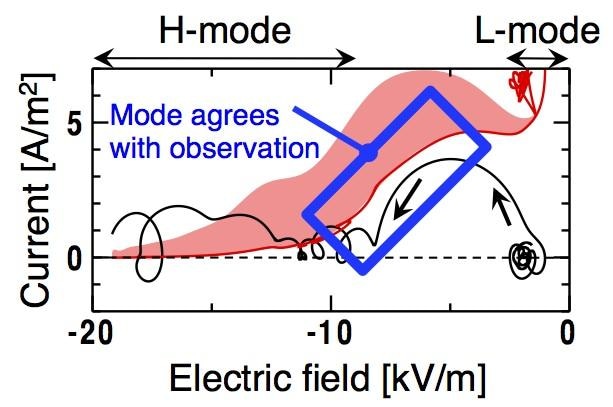Aug 5 2016
In seeking the realization of the fusion reactor, research on confining high temperature and high density plasma in the magnetic field is being conducted around the world. One of the most important issues in realizing the power generation reactor is the problem that "turbulence," which is the turbulent flow of plasma, causes plasma confinement deterioration. When turbulence) exists, plasma with a high core temperature is expelled to outside the plasma, and the condition for producing fusion cannot be achieved. The key to solving this problem was accidentally discovered on a German experimental device in 1982. There, turbulence in the edge region was suppressed, and the plasma state called the "H-mode"), in which the temperature of the entire plasma was raised, was realized. In contrast to this, plasma in which turbulence is great and the temperature is low is called "L-mode" plasma. Subsequently, H-mode plasma was reproduced in devices around the world. H-mode is used as the standard operation mode in the ITER.
 The right side of the figure where the electric field's absolute value is small corresponds to the L-mode plasma and the left side having large electric field to the H-mode. The black line indicates the experimental value of the electric current and the red line the theoretical value used in the model based upon differences in the trajectories. (credit: Tatsuya Kobayashi)
The right side of the figure where the electric field's absolute value is small corresponds to the L-mode plasma and the left side having large electric field to the H-mode. The black line indicates the experimental value of the electric current and the red line the theoretical value used in the model based upon differences in the trajectories. (credit: Tatsuya Kobayashi)
In research to date, many researchers have attempted to clarify the H-mode mechanism. In the normal condition in which there is a balance of ions and electrons, there cannot be a strong electric field in a plasma. This condition corresponds to the L-mode. According to theory, in the H-mode, due to a small deviation in the distribution of ions and electrons, in the plasma's edge region a strong electric field is generated, and suppression of the turbulence was predicted. Subsequently, using the most advanced diagnostics at that time, the structure of the electric field that theoretical researchers had predicted was shown to actually exist. How does this structure of the electric field form was the remaining riddle. Regarding this riddle, research has been advancing since the discovery of the H-mode, and this issue was not solved for more than thirty years, until now.
Here, the research group of professors Tatsuya Kobayashi, Kimitaka Itoh, and Takeshi Ido of NIFS engaged in collaborative research with the National Institutes for Quantum and Radiological Science and Technology (QST) and Kyushu University. Using the "Heavy Ion Beam Probe" developed at NIFS they measured the plasma potential of the QST's JFT-2M tokamak. Resulting from their analysis of experimental data they discovered the electric field generation mechanism which had been a riddle for the past thirty years.
The "deviation" in the distribution of ions and electrons producing the strong electric field is made by the electric current that flows in the radial direction. The mechanism that produces this electric current has been proposed numerous times, but which effect was especially important had not yet been clarified. Through their measurements and analysis, they found that the effects born from the differences in the trajectories of electrons and ions play a particularly important role in the generation of the electric current. Although the experimental data used in these experiments were collected in 1999, they produced cutting edge results from recent theoretical physics and developments in analytical methods. That results from seventeen years earlier have contributed to advances in plasma physics today indicates the high quality of this experimental data.